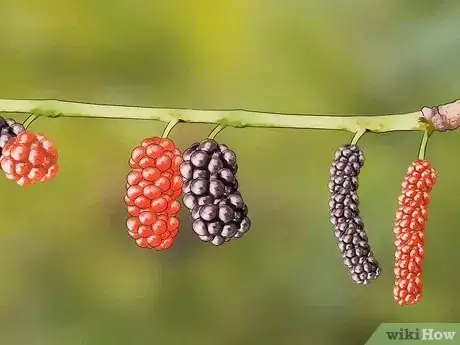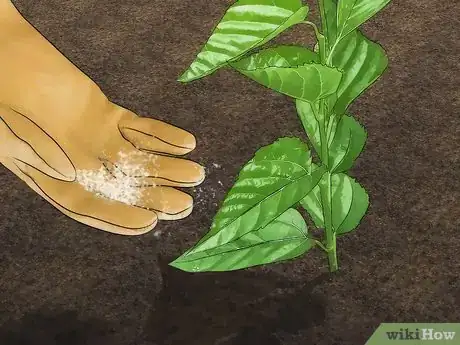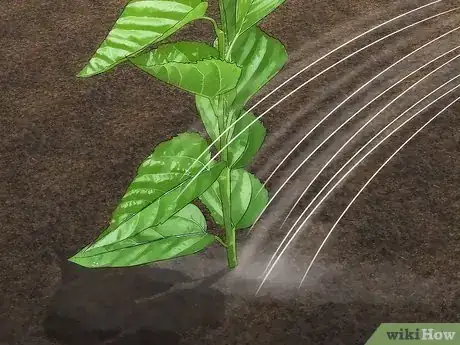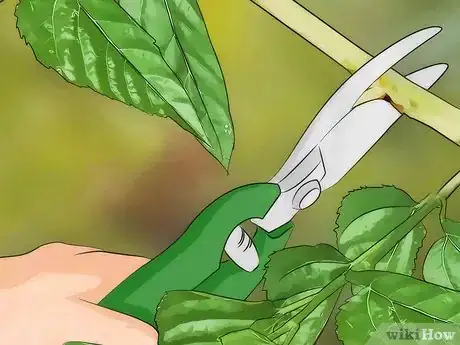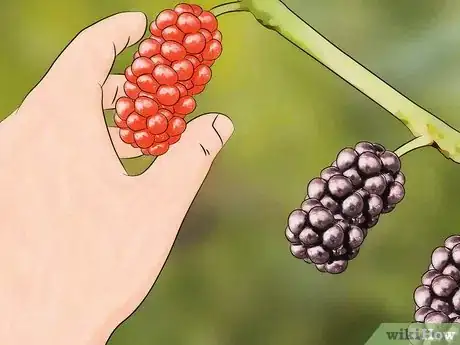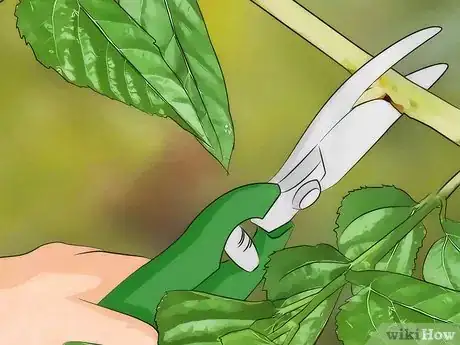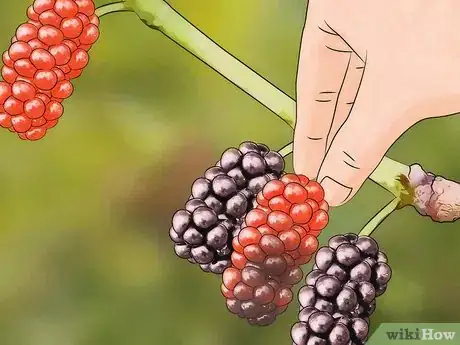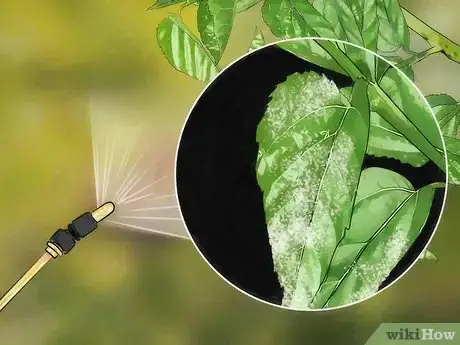This article was co-authored by Lauren Kurtz. Lauren Kurtz is a Naturalist and Horticultural Specialist. Lauren has worked for Aurora, Colorado managing the Water-Wise Garden at Aurora Municipal Center for the Water Conservation Department. She earned a BA in Environmental and Sustainability Studies from Western Michigan University in 2014.
There are 11 references cited in this article, which can be found at the bottom of the page.
wikiHow marks an article as reader-approved once it receives enough positive feedback. In this case, 84% of readers who voted found the article helpful, earning it our reader-approved status.
This article has been viewed 142,771 times.
Mulberry trees are large members of the Moraceae family that range in height from 30-50 feet. While some mulberries come in the form of small bushes, the fruit-bearing types are large trees. They are known to be hardy, self-pollinating, deciduous trees. The fruit from mulberry trees ripen in midsummer and have been known to produce delicious, mild, and sweet drupes that resemble blackberries. By learning how to correctly plant and maintain your mulberry tree, you can enjoy both the tree and its fruit for years to come.
Steps
Planting Your Mulberry Tree
-
1Select a cultivar. Be sure to ask your nursery or catalog to specify the type of cultivar you are purchasing. When acquiring a mulberry tree for fruit, choose a cultivar that is strong, self-pollinating, and has seedless fruits. There are also fruitless and weeping cultivars available for purchase if you are not interested in a fruit-bearing tree. Search for hardy and lush cultivars for planting.
- The Morus alba (white mulberry) and Morus rubra (red mulberry) hybrids (such as the Downing and Illinois Everbearing) are known for their large, sweet, fruit and hardiness.
-
2Choose the right soil. Mulberry trees will grow on many types of soil as long as a good drainage system is provided. Ensure they are not in an area where flooding is common as they do not tolerate being engulfed in water. When possible, well-drained, deep soils are preferred. Opt for slightly acidic soil with a pH of 5.5 to 6.5. Soils of moderate alkalinity are able to be tolerated.
- If you are unsure of the pH of your soil, take a sample to the Cooperative Extension Agency in your county.
Advertisement -
3Pick a location for planting. Mulberry trees are able to survive in drought and salty conditions so they are typically good for urban or coastal planting. They thrive in climates that see seasonal temperature changes including sunny summers and frosty winters. The fruit that falls from trees may cause dark stains so avoid planting near walkways or driveways as the branches can be very weak.
- Chickens, turkeys and pigs enjoy mulberries so you can always choose to plant a mulberry tree where it will overhang and offer your animals a treat.
-
4Determine the best season for planting. While there is no particular season that is best for planting, the rule of thumb is that planting is fine when conditions are “favorable”. You should not plant when the ground is frozen, when daytime temperatures are below 32ºF or above 90ºF, or when there’s extreme weather such as blizzards or torrential rain.[1]
-
5Prepare the planting hole and plant your tree. Your planting hole should be about 3 times the width of the pot, as deep as the root ball. There should also be 25–30 feet (7.6–9.1 m) between each tree, though some varieties will be fine with 15 feet (4.6 m). Mix the soil that has been set aside with aged mushroom compost, aged manure, or rotted pine bark (half and half). Remove the plant from the pot, loosen the root, and place it in the hole. Fill the hole with the soil mixture previously set aside, and water it to allow the roots to settle.
- Avoid burying the root too deeply by making sure the top most roots are positioned at the soil line.
- Avoid adding fertilizer to the planting hole unless it is during an appropriate fertilization time. Fertilization is based on the age of the tree and can occur anywhere from February to August.
Maintaining Your Mulberry Tree
-
1Fertilize your mulberry tree. Your fertilizer should contain iron, zinc, manganese, magnesium, molybdenum, copper and boron. An NPK value of 10-10-10 is good. When applying the fertilizer, spread evenly under the canopy of the tree by watering or raking into the soil. Avoid spreading fertilizer within the 5-inch area around the trunk of the tree.[2]
- The time and frequency of adding fertilizer depends on the tree’s age.
- Most mulberry trees thrive with little to no fertilization. Fertilizing once per year should be fine.
- Avoid fertilizing more than twice a year and begin in March but no later than July. Fertilizing after August will result in freeze damage.[3]
-
2Water it. Water your mulberry tree twice a week if it is surrounded by light soils, and water once a week if planted on clay soil. It should take you 40-50 minutes to ensure that the root system is completely soaked. Each week, your tree should receive at least 1 inch of water, especially during extremely dry periods.
- You don’t need to manually water your tree if you receive at least 1 inch of rain in your area.[4]
- Fruit may fall from the tree prematurely if it doesn’t receive ample water. The best way to avoid dry spells is to let your garden hose slowly trickle to allow the water to penetrate the roots instead of running off.
-
3Prune your mulberry tree. Pruning wil help keep your tree tidy and healthy and make for an easier harvest. Removal of dead, diseased or crossed branches should be done in winter when the tree is dormant. Avoid pruning in mid-summer to allow the tree to set for the upcoming year’s fruit buds. Cuts should follow the shape of the tree and should never be more than 2 inches in diameter.[5]
- You should need no more than 5 cuts to prune a healthy mulberry tree.
- Cuts over 2 inches in diameter can lead to bleeding, from which your tree is not likely to heal. They also leave your tree vulnerable to certain diseases and fungi.
-
4Harvest the fruit from your tree. You can harvest the fruit by handpicking them, or laying a sheet or tarp under the tree and gently shaking the branches. Do not harvest before May or your fruit may not be fully ripened. Your berries are ripe when they are large, sweet and black. Taste one to be sure.[6]
- When placing your fruit in a container, avoid layering too many or the berries at the bottom of the container will be crushed.
- Your unwashed harvest can be stored for several days in a covered container in the refrigerator.
- Your harvest can also be kept for several month by washing the berries, patting them dry, and placing them in freezer bags.
Controlling Pests and Diseases
-
1Maintain and prune to avoid sooty canker disease. Sooty canker is a wilt disease that affects limbs and branches of mulberry trees. Trees that are affected usually wilt in hot seasons, have cankers on limbs that eventually die back, and have brownish cracks that split open to reveal fungi. Keeping the tree fertilized and appropriately watered will help to prevent canker disease. If infection appears to be affecting branches, trim limbs at least 1 foot below the site of infection.[7]
- There’s no chemical control for sooty canker disease, so always make sure to prune dead branches as soon as you recognize them to avoid spreading the disease. Burn the diseased branches, too.
- Avoid over-watering and over-fertilizing as this stresses the tree and makes it more susceptible to disease.
- Always make sure you clean your pruning tools with rubbing alcohol after use.[8]
-
2Pick and discard infected fruit to avoid popcorn disease. Popcorn disease is caused by fungus and occurs in late spring and early summer.[9] The fruit becomes large and extends more prominently than healthy fruit, until it resembles popcorn. The best prevention method is to pick and discard any fruit that appears to be infected, including any fruit that has fallen.[10]
- The disease isn’t harmful to the tree itself so if you aren’t interested in the fruit, you don’t have to worry about preventing the infection.
- You can also try spraying the tree with a Bordeaux mixture to treat the disease. However, it is often not effective because it is difficult to spray down the entire tree.[11]
-
3Avoid powdery mildew through fungicide treatments. Powdery mildew is caused by fungi and is evident when the leaf’s surface appears to be covered by a white, powdery substance.[12] You can control the mildew by spraying your tree with an approved fungicide such as Serenade Garden Disease Control.[13]
- Mixture ratios and spraying guidelines vary based on your tree. Be sure to read and follow printed instructions on the manufacturer’s bottle.[14]
Expert Q&A
-
QuestionDo mulberry trees need a lot of sun?
 Lauren KurtzLauren Kurtz is a Naturalist and Horticultural Specialist. Lauren has worked for Aurora, Colorado managing the Water-Wise Garden at Aurora Municipal Center for the Water Conservation Department. She earned a BA in Environmental and Sustainability Studies from Western Michigan University in 2014.
Lauren KurtzLauren Kurtz is a Naturalist and Horticultural Specialist. Lauren has worked for Aurora, Colorado managing the Water-Wise Garden at Aurora Municipal Center for the Water Conservation Department. She earned a BA in Environmental and Sustainability Studies from Western Michigan University in 2014.
Professional Gardener Ideally, yes. Mulberry trees will produce more fruit with more sun. They do best with at least 6-8 hours of direct sunlight per day.
Ideally, yes. Mulberry trees will produce more fruit with more sun. They do best with at least 6-8 hours of direct sunlight per day. -
QuestionAre mulberries good to eat?
 Lauren KurtzLauren Kurtz is a Naturalist and Horticultural Specialist. Lauren has worked for Aurora, Colorado managing the Water-Wise Garden at Aurora Municipal Center for the Water Conservation Department. She earned a BA in Environmental and Sustainability Studies from Western Michigan University in 2014.
Lauren KurtzLauren Kurtz is a Naturalist and Horticultural Specialist. Lauren has worked for Aurora, Colorado managing the Water-Wise Garden at Aurora Municipal Center for the Water Conservation Department. She earned a BA in Environmental and Sustainability Studies from Western Michigan University in 2014.
Professional Gardener Mulberries are very good to eat or cook with, such as making pie or preserves. There are different species with varying levels of sweetness.
Mulberries are very good to eat or cook with, such as making pie or preserves. There are different species with varying levels of sweetness. -
QuestionHow long does it take for a mulberry tree to bear fruit?
 Lauren KurtzLauren Kurtz is a Naturalist and Horticultural Specialist. Lauren has worked for Aurora, Colorado managing the Water-Wise Garden at Aurora Municipal Center for the Water Conservation Department. She earned a BA in Environmental and Sustainability Studies from Western Michigan University in 2014.
Lauren KurtzLauren Kurtz is a Naturalist and Horticultural Specialist. Lauren has worked for Aurora, Colorado managing the Water-Wise Garden at Aurora Municipal Center for the Water Conservation Department. She earned a BA in Environmental and Sustainability Studies from Western Michigan University in 2014.
Professional Gardener It can take a mulberry tree 10 years to reach maturity. When grown from seed, they likely won't bear fruit for at least 8-10 years.
It can take a mulberry tree 10 years to reach maturity. When grown from seed, they likely won't bear fruit for at least 8-10 years.
Warnings
- Don’t treat your tree with toxic pesticides and fungicides if you plan on eating the fruit.⧼thumbs_response⧽
- Don't wash the berries until you are about to use them.⧼thumbs_response⧽
References
- ↑ http://www.starkbros.com/growing-guide/article/the-best-time-to-plant
- ↑ http://www.starkbros.com/growing-guide/how-to-grow/fruit-trees/mulberry-trees/fertilizing
- ↑ http://www.starkbros.com/growing-guide/how-to-grow/fruit-trees/mulberry-trees/fertilizing
- ↑ http://www.starkbros.com/growing-guide/how-to-grow/fruit-trees/mulberry-trees/watering
- ↑ http://www.starkbros.com/growing-guide/how-to-grow/fruit-trees/mulberry-trees/pruning
- ↑ http://www.starkbros.com/growing-guide/how-to-grow/fruit-trees/mulberry-trees/pest-and-disease-control
- ↑ https://www.unce.unr.edu/publications/files/ho/other/fs9626.pdf
- ↑ http://www.starkbros.com/growing-guide/article/spraying-dormant-oil
- ↑ https://msfruitextension.wordpress.com/2015/05/18/popcorn-disease-of-mulberry/
- ↑ http://plantdiseasehandbook.tamu.edu/landscaping/trees/mulberry/
- ↑ https://msfruitextension.wordpress.com/2015/05/18/popcorn-disease-of-mulberry/
- ↑ http://plantdiseasehandbook.tamu.edu/landscaping/trees/mulberry/
- ↑ http:// http://plantdiseasehandbook.tamu.edu/landscaping/trees/mulberry/
- ↑ http://plantdiseasehandbook.tamu.edu/landscaping/trees/mulberry/
